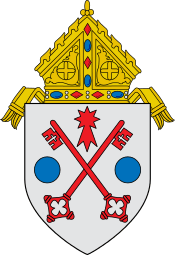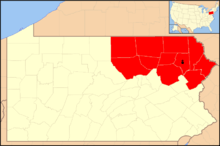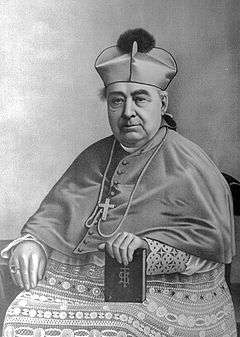Roman Catholic Diocese of Scranton
| Diocese of Scranton Dioecesis Scrantonensis | |
|---|---|
 The coat of arms of the Diocese of Scranton | |
| Location | |
| Country | United States of America |
| Territory | Northeastern Pennsylvania |
| Ecclesiastical province | Philadelphia |
| Statistics | |
| Area | 22,913 km2 (8,847 sq mi) |
| Population - Total - Catholics |
(as of 2014) 1,118,000 (est.) 348,600 (est.) (31.2%%) |
| Parishes | 120 |
| Churches | 167 |
| Schools | 19 |
| Information | |
| Denomination | Roman Catholic |
| Rite | Roman Rite |
| Established | March 3, 1868 |
| Cathedral | St. Peter's Cathedral |
| Patron saint | Saint Peter |
| Secular priests | 252 |
| Current leadership | |
| Pope | Francis |
| Bishop |
Joseph Bambera Bishop of Scranton |
| Metropolitan Archbishop |
Charles Chaput, OFM Cap Archbishop of Philadelphia |
| Map | |
 | |
| Website | |
| dioceseofscranton.org | |
The Roman Catholic Diocese of Scranton is a suffragan see of Archdiocese of Philadelphia, established on March 3, 1868. The seat of the bishop is St. Peter's Cathedral in Scranton, PA. Other cities in the diocese are Wilkes-Barre, Williamsport, Hazleton, Nanticoke, Carbondale, and Pittston.
The diocese comprises Lackawanna, Luzerne, Bradford, Susquehanna, Wayne, Tioga, Sullivan, Wyoming, Lycoming, Pike, and Monroe counties, all in the northeastern part of Pennsylvania. The area of the diocese is 8,487 square miles (21,980 km2).
On February 23, 2010, Pope Benedict XVI appointed Monsignor Joseph C. Bambera the tenth Bishop of Scranton. Bambera was ordained and installed as bishop on April 26, 2010, at St. Peter’s Cathedral. Cardinal Justin Rigali, Archbishop of Philadelphia, served as principal consecrator and James Timlin, Bishop Emeritus of Scranton, and John Dougherty, former Auxiliary Bishop of Scranton, served as co-consecrators. Pietro Sambi, the Apostolic Nuncio (papal ambassador) to the United States, read the papal appointment letter.[1][2]
Early history
The first Catholic settlers in the area were principally of Irish and German descent. In the late 19th and early 20th centuries, Slavic and Italian populations attracted by the coal-mining industry came to comprise one-half of the Catholic population.
Although many of the early settlers were Catholic immigrants, the first official visit of a priest to this territory of which there is any authentic record was not until 1787. In that year James Pellentz traveled from Baltimore up the Susquehanna River as far as Elmira, New York, ministering to the Catholics scattered through this region.[3] A few years later, the famous French settlement of Asylum or "Azilum" was founded (1793–94). Planned as a retreat for French nobility, the site chosen was on the banks of the Susquehanna River, opposite the present village of Standing Stone in Bradford County. Today scarcely a trace of this unique settlement remains.
The earliest permanent Catholic settlements were at Friendsville and Silver Lake in Susquehanna County. These, as well as the other Catholic settlers scattered throughout this district, were attended occasionally by priests sent from Philadelphia. In 1825, largely due to the solicitations of Patrick Griffin, father of Gerald Griffin, Francis Kenrick, Bishop of Philadelphia, sent the Rev. John O'Flynn as the first resident pastor. His work, however, was similar to that of a missionary, as his field of labor comprised thirteen counties in northeastern Pennsylvania and five counties in New York state.
The first church in the diocese was built in 1825 near Silver Lake. Father O'Flynn died at Danville in 1829, and was succeeded by Father Clancy. On February 1, 1836, Henry Fitzsimmons was sent to take charge of this territory and took up his residence in Carbondale, where a church had been built in 1832. In 1838 John Vincent O'Reilly was sent by Kenrick to assist in administering to the Catholics of this extensive territory. He took up his residence at Silver Lake and his charge comprised Susquehanna, Bradford, Tioga, Potter and Sullivan counties in Pennsylvania and the five adjoining counties in New York. The early history of the diocese is intimately bound to the labors of Father O'Reilly and the foundations of many present parishes were the results of his missionary zeal.
Bishops
Bishops of Scranton
The following bishops have served as the diocesan bishop of the Diocese of Scranton.

- William O'Hara (1868-1899)[4]
- Michael Hoban (1899-1927)
- Thomas C. O'Reilly (1927-1938)
- William Hafey (1938-1954)
- Jerome Hannan (1954-1965)
- J. Carroll McCormick (1966-1983)
- John O'Connor (1983-1984), appointed Archbishop of New York (elevated to Cardinal in 1984)
- James Timlin (1984-2003)
- Joseph Martino (2003-2009)
- Joseph Bambera (2010-present)
Coadjutor Bishops
- Michael Hoban (1896-1899)
- William Hafey (1937-1938)
Auxiliary Bishops
- Andrew Brennan (1923-1926, appointed Bishop of Richmond
- Martin O'Connor (1942-1946), appointed Rector of the Pontifical North American College and later President of the Pontifical Council for Social Communications and Apostolic Nuncio and Titular Archbishop
- Henry Klonowski (1947-1973)
- James Timlin (1976-1984), appointed Bishop of Scranton
- Francis X. DiLorenzo (1988 to 1994), appointed Bishop of Honolulu and later Bishop of Richmond
- John Dougherty (1995-2009)
Other priest in the diocese who became bishop
- Joseph Kopacz, appointed Bishop of Jackson
Education
Catholic education in the diocese began with the pioneer Father O'Reilly. In the autumn of 1842, he opened a college at St. Joseph's, Susquehanna County. Under his supervision, it grew and flourished and in the 22 years of its existence, the college educated two bishops and over 20 priests. It was destroyed by fire on January 1, 1864 and was never rebuilt. St. Thomas College was established in 1888 and came under the direction of the Christian Brothers. In 1938, it was elevated to become the University of Scranton. The Society of Jesus took charge of its governance in 1942. Marywood University, also in Scranton, was founded and is operated by the Sisters of the Immaculate Heart of Mary. King's College in Wilkes-Barre is operated by the Congregation of the Holy Cross. And, in Dallas, Misericordia University was founded by the Religious Sisters of Mercy in 1924.
In the 1940s, it opened the South Scranton Catholic High School, later Bishop Klonowski High School. The school closed in 1982.[5]
Due to rapidly declining enrollment and mounting financial obligations, Joseph Martino employed the Meitler Consultants to assess the catholic schools and provide recommendations to restructure the education system. The final decisions, made in January 2007, resulted in the consolidation of all schools as under direct diocesan control. It created four regional systems (as shown below), and closed many individual schools. All of the secondary education centers in Lackawanna and Luzerne Counties were closed and replaced by two regional schools: Holy Cross High School to serve Lackawanna County and Holy Redeemer High School to serve Luzerne County. The curriculum of the diocese was standardized to promote continuity and uniformity in the education of the students, and improvements have been visible in the results of college attendance and standardized test results, which consistently rank well above the area's public schools. In April 2010, Bishop Joseph Bambera announced an adjustment of the diocesan school system, which dealt with financial contributions, marketing and promotion of the schools, and the closure of four elementary school sites.
As of the 2011-2012 school year, the Diocese of Scranton operates six early childhood centers,[6] sixteen elementary schools[6] and four high schools,[6] as shown below (in alphabetical order of the municipality in which they occur). Regional Systems are delineated and high school centers are in boldface.
Early childhood centers
- Saint Gregory Early Childhood Center, Clarks Green
- Saint Vincent DePaul Pre-School, Milford
- Saint Catherine Pre-School, Moscow
- Saint John Neumann Early Childhood Center, Muncy
- Domiano Early Childhood Center, Scranton
- Immaculate Care Pre-School, Scranton
Holy Cross School System
- Holy Cross High School, Dunmore
- Our Lady of Peace Elementary, Clarks Summit
- Saint Mary of Mount Carmel Elementary, Dunmore
- LaSalle Academy, Dickson City & Jessup
- Epiphany Elementary, Sayre
- All Saints Academy, Scranton
- Saint Clare/Saint Paul Elementary, Scranton
- Saint Agnes Elementary, Towanda
Holy Redeemer School System
- Holy Redeemer High School, Wilkes-Barre
- Holy Rosary Elementary School, Duryea
- Wyoming Area Catholic Elementary School, Exeter
- Holy Family Academy, Hazleton
- Good Shepherd Academy, Kingston
- Saint Nicholas/Saint Mary Elementary School, Wilkes Barre
- Saint Jude Elementary School, Mountain Top
Notre Dame School System
- Notre Dame High School, East Stroudsburg
- Monsignor McHugh Elementary, Cresco
- Notre Dame (Elementary and Middle), East Stroudsburg
Saint John Neumann School System
- St. John Neumann Regional Academy High School, Williamsport
- Saint John Neumann Regional Academy Elementary, Williamsport
Non-diocesan
- Scranton Preparatory School, Scranton (Society of Jesus)
Religious institutes
- Religious Sisters of Mercy of the Americas (RSM)
- Congregation of Sisters, Servants of the Immaculate Heart of Mary (IHM), Marywood University
- Sisters of Christian Charity (SCC)
- Sisters of Sts. Cyril and Methodius (ScCM)
- Congregation of Notre Dame (CND)
- Bernardine Sisters of St. Francis (OSF)
- Little Sisters of the Poor
- Society of Jesus (SJ, Jesuits), University of Scranton and Scranton Preparatory School
- Congregation of Holy Cross (CSC), King's College
- Congregation of the Passion (CP-Passionists), St. Ann's Basilica and Monastery
- Sisters of Mercy, Misericordia University
- Oblates of St. Joseph (OSJ-Italian)
- Priestly Fraternity of St. Peter (FSSP-North American District Headquarters)
- Religious Teachers Filippini (MPF), SS. Anthony and Rocco Convent, Dunmore
- Sovereign Military Order of Malta (SMOM)
Sex abuse investigation
In early 2016, a grand jury investigation, led by Pennsylvania Attorney General Josh Shapiro, began an inquiry into sexual abuse by Catholic clergy in six Pennsylvania dioceses: Scranton, Allentown, Harrisburg, Pittsburgh, Greensburg, and Erie.[7] The Diocese of Altoona-Johnstown and the Archdiocese of Philadelphia were not included, as they had been the subjects of earlier investigations.[7]
On July 27, 2018, the Pennsylvania Supreme Court ordered that a redacted copy of the grand jury report be released to the public.[8] On August 6, 2018, the Diocese released a statement stating that Bishop Bambera would cooperate with the investigation and publish the list of "credibly accused clergy" when the grand jury report is published.[9] The grand jury report was published on August 14, 2018 and showed that 301 clergy were accused of sexually abusing of children, with 59 coming from the Diocese of Scranton.[10]
On August 31, 2018, Bishop Bambera forbade former bishop James Timlin from representing the diocese in public, given Timlin's failure to protect children from abusers.[11] Bambera himself had served as the Vicar for Priests for the Diocese of Scranton from 1995 to 1998, and he admitted that during that time he had helped then-Bishop Timlin reassign a priest who had abused a minor, although the decision was made by Timlin.[11] Bambera emphasized that since becoming bishop in 2010, he has pursued a zero-tolerance policy toward clerical abuse.[11]
See also
- Catholic Church by country
- Catholic Church in the United States
- Ecclesiastical Province of Philadelphia
- Global organisation of the Catholic Church
- List of Roman Catholic archdioceses (by country and continent)
- List of Roman Catholic dioceses (alphabetical) (including archdioceses)
- List of Roman Catholic dioceses (structured view) (including archdioceses)
- List of the Catholic dioceses of the United States
References
- ↑ Laura, Legere (2010-04-24). "Retired bishops to welcome new bishop at ordination". Scranton Times. Retrieved 2010-05-02.
- ↑ Laura, Legere (2010-04-27). "Bambera installed as new bishop of Scranton". Scranton Times. Retrieved 2010-05-02.
- ↑ Frederick Lewis Weis (1978). The Colonial Clergy of the Middle Colonies: New York, New Jersey, and Pennsylvania, 1628-1776. Baltimore: Genealogical Publishing Com. p. 121. ISBN 978-0-8063-0799-2. Terry Carden (2005). Coming of Age In Scranton: Memories of a Puer Aeternus. Lincoln NE: iUniverse. p. 5. ISBN 978-0-595-80765-9.
- ↑ O'Hara was consecrated a bishop by Cardinal Giacomo Fransoni. Ritzler, Remigius; Pirminus Sefrin (1978). Hierarchia catholica Medii et recentioris aevi... A Pontificatu PII PP. IX (1846) usque ad Pontificatum Leonis PP. XIII (1903) (in Latin). Volume VIII. Il Messaggero di S. Antonio. p. 505.
- ↑ "National Historic Landmarks & National Register of Historic Places in Pennsylvania" (Searchable database). CRGIS: Cultural Resources Geographic Information System. Note: This includes Cynthia A. Rose (1996). "National Register of Historic Places Inventory Nomination Form: Roger Williams Public School No. 10" (PDF). Retrieved 2012-01-03.
- 1 2 3 "Locate a School « Diocese of Scranton". Dioceseofscranton.org. Retrieved 2018-04-03.
- 1 2 Couloumbis, Angela (June 17, 2018). "Pa. report to document child sexual abuse, cover-ups in six Catholic dioceses". The Philadelphia Inquirer. Retrieved August 2, 2018.
- ↑ Couloumbis, Angela; Navratil, Liz (July 27, 2018). "Pa. Supreme Court: Release redacted report that names more than 300 'predator priests'". The Philadelphia Inquirer. Retrieved August 1, 2018.
- ↑ https://www.timesleader.com/news/714209/bambera-will-release-names-once-grand-jury-report-is-made-public
- ↑ https://wnep.com/2018/08/14/attorney-general-lists-dozens-of-priests-accused-of-sex-abuse-in-grand-jury-report/
- 1 2 3 Michael Rubinkam (September 5, 2018). "As bishop looks on, abusive Father Ned gets a new assignment". Crux. Retrieved September 5, 2018.
Books
- Earley, James Benedict (1994). Envisioning Faith: The Pictorial History of the Diocese of Scranton. Devon PA USA: W.T. Cooke Pub.
- Gallagher, John P. (1968). A Century of History: The Diocese of Scranton, 1868-1968. Scranton: Diocese of Scranton.
- Gallagher, John P. (1993). A Second Century Begins: The Diocese of Scranton, 1968-1993. Scranton: Diocese of Scranton.
- Kashuba, Cheryl A.; Miller-Lanning, Darlene; Sweeney, Alan (2005). Scranton. Charleston SC USA: Arcadia Publishing. ISBN 978-0-7385-3859-4.
- Keenan, Sister M. Michel, IHM (2016). The Sisters, Servants of the Immaculate Heart of Mary: Scranton, Pennsylvania: 1974-1994. Pittsburgh PA: Dorrance Publishing. ISBN 978-1-4809-1956-3.
- McCook, Brian (2011). The Borders of Integration: Polish Migrants in Germany and the United States, 1870-1924. Athens OH: Ohio University Press. ISBN 978-0-8214-1926-7.
- Włdarski, Szczepan (1974). The Origin and Growth of the Polish National Catholic Church. Scranton PA: Polish National Catholic Church.
- Zawistowski, Theodore L. (1998). Bishop Francis Hodur: Biographical Essays. East European Monographs. ISBN 978-0-944497-12-8.
External links
Coordinates: 41°24′36″N 75°39′47″W / 41.41001°N 75.66297°W